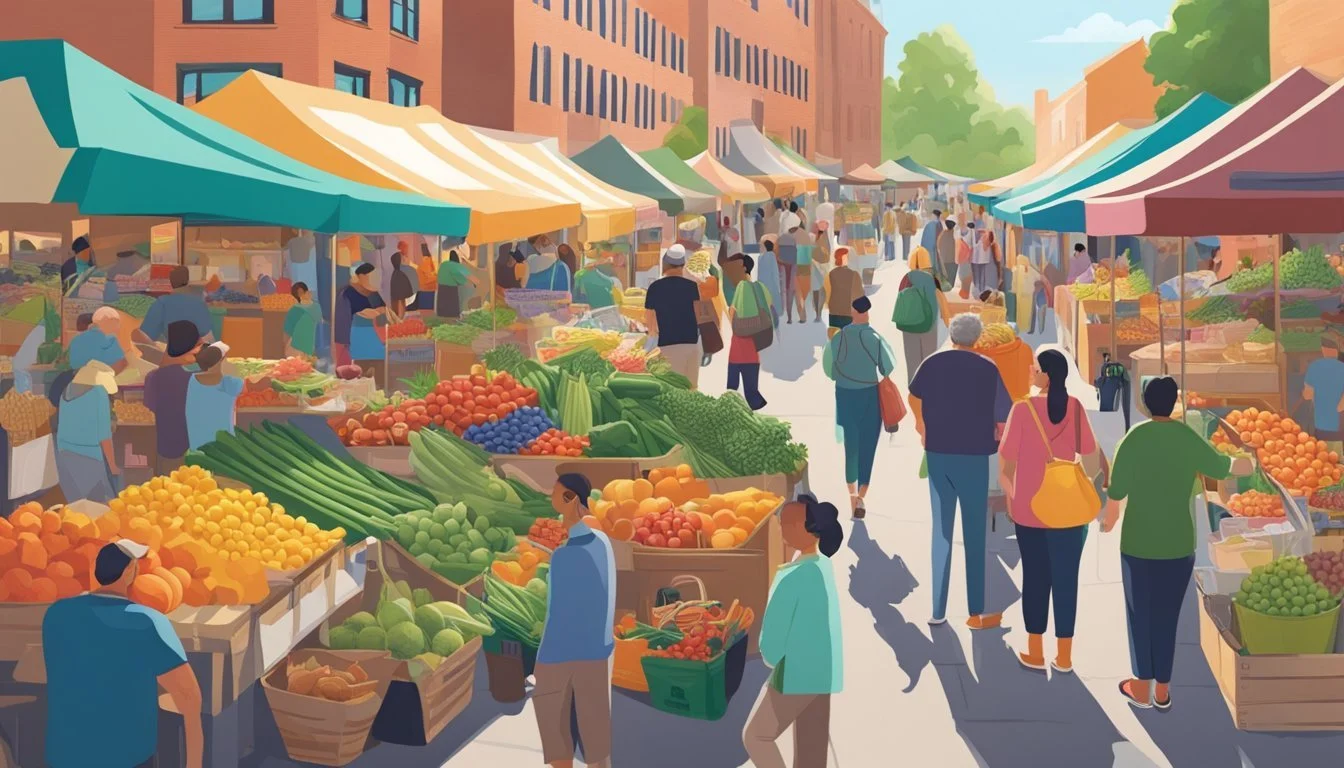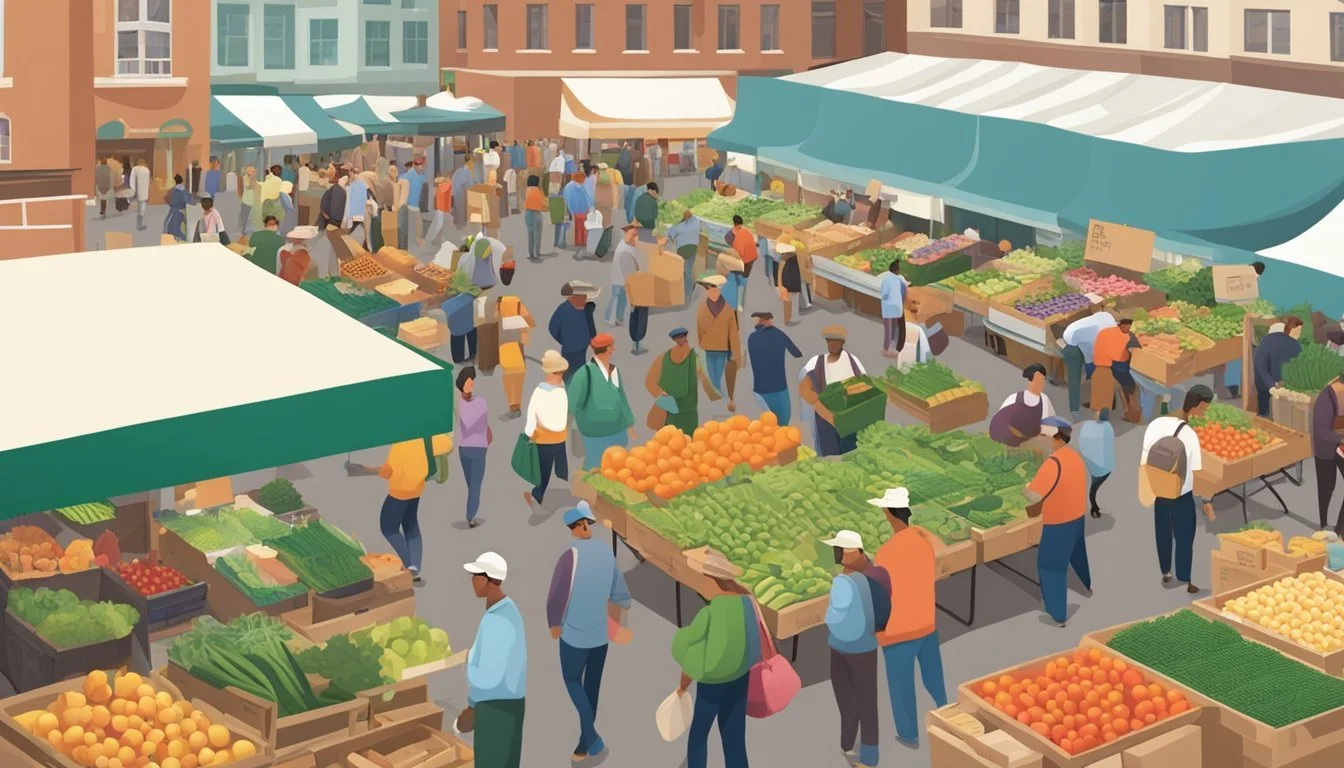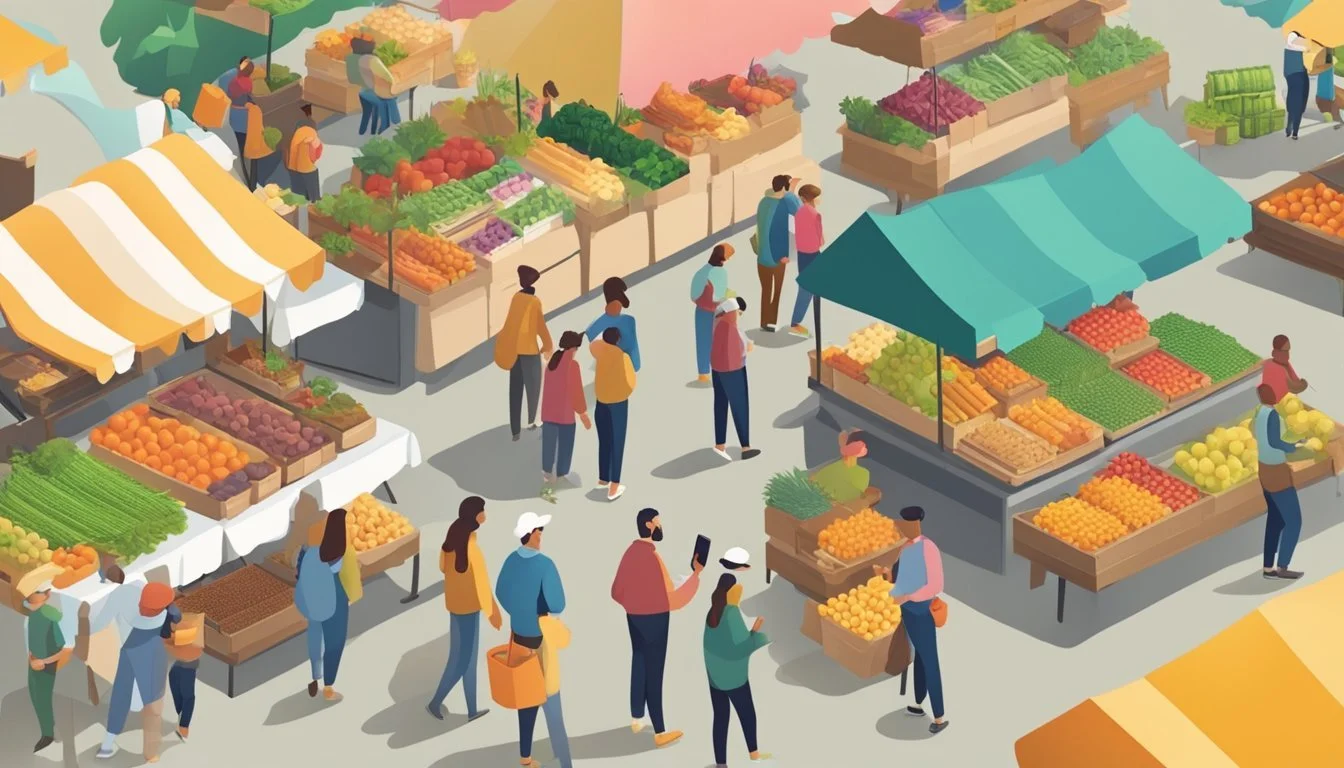How to Navigate Crowds and Lines at Busy Farmers' Markets
Efficient Strategies for Shoppers
Navigating busy farmers' markets can be an exciting yet challenging experience. These local gatherings are a vibrant intersection of community, commerce, and culture, offering consumers direct access to fresh produce and artisan goods. As they grow in popularity, farmers' markets also become hotspots for individuals seeking not only the freshest ingredients but also an environmentally friendly shopping option that supports local economies. However, the increase in foot traffic brings with it the inevitable crowds and long lines that can overwhelm even the most seasoned market-goers.
One of the key strategies to a stress-free visit is timing. Arriving early, preferably as the market opens, ensures a more tranquil and manageable environment, allowing visitors to meander through stands and engage with vendors without the pressure of bustling hordes. This also presents an opportunity to access the best selection of goods, as products are less likely to have run out. To maintain this ease throughout the visit, carrying small denominations of cash streamlines transactions, making for swift and simple exchanges that keep lines moving.
Understanding the ebb and flow of a farmers' market is crucial for an enjoyable experience. Regular attendees learn to recognize not only the patterns of the crowd but also the rhythms of the market — when certain produce is likely to arrive, which vendors have the quickest queues, and how to navigate the space efficiently. Implementing these tips, anyone can become adept at handling the sometimes overwhelming nature of a busy farmers' market, turning what could be a daunting task into a delightful weekly excursion.
Planning Your Visit
When visiting a farmers' market, a well-considered plan can maximize efficiency, ensure one obtains the best produce, and enhance overall experience. Creating a shopping list, checking seasonal availability, determining when and where markets operate, and understanding their layout are critical steps.
Creating a Shopping List
One should draft a shopping list to stay focused amid the abundance. This list not only streamlines the shopping process but also helps to resist impulse purchases, which can quickly add up. A precise list is conducive to a quicker market visit, which is crucial during peak hours.
Checking Seasonal Availability
Shoppers should research and note the seasonal produce available to adjust their shopping lists accordingly. This leads to the enjoyment of the freshest, most flavorful produce and supports local agriculture. Most farmers' markets feature seasonal guides either online or onsite.
Determining Market Hours and Locations
It's advantageous to know the operational hours and locations of nearby farmers' markets. Those who plan and arrive early typically face fewer crowds and have access to the best selection of goods. Market hours and locations can often be found on Local Harvest or market websites.
Understanding the Layout of the Market
A grasp of the market's layout, which can typically be sourced from market maps available online or at the market itself, allows for a more efficient visit. Awareness of where specific vendors are located helps in navigating the market directly to one's desired stalls, saving time and avoiding the thickest crowds.
Making the Most of Your Time
Maximizing efficiency during your visit to a busy farmer's market involves preparation and strategic approaches to shopping. It's essential to come equipped and have a clear plan for payment and navigation.
Bringing Your Own Bags
Shoppers can save time and support sustainability by bringing their own reusable bags. Farmers' markets often involve purchasing an array of produce, and having sturdy, reusable bags at hand eliminates the wait for packaging and facilitates the transportation of goods. It simplifies the process for both the shopper and the vendor, as it reduces the need for handing out plastic or paper bags.
Carrying Cash and Cards
While many farmers accept credit cards nowadays, having cash readily available can expedite transactions. Smaller bills are preferred for quick change-making. A wallet organized with both cash and cards offers flexibility, allowing shoppers to use the appropriate method depending on the stall's payment system. This best practice ensures a smooth and swift checkout, keeping both customers and farmers efficient.
Preferred Payment Methods for Efficiency
Cash: Small bills for quick transactions
Credit Cards: For larger purchases or card-only stalls
Navigating Through Stalls Efficiently
Efficient navigation through stalls is crucial to make the most of one's time at a farmer's market. Shoppers should scout the market layout quickly upon arrival, identifying the location of their favorite farmers and produce. A planned route minimizes backtracking and wasted time. Prioritizing stalls with unique or in-demand items can save time and ensure the best selection. Remember, polite and assertive navigation helps maintain a steady flow of foot traffic.
Navigation Tips:
Scout the layout upon arrival
Plan a route to prioritize visits
Be polite and assertive in crowds
Engaging with Vendors
Engaging with vendors at farmers' markets enriches the shopping experience and can provide a wealth of knowledge about the items on offer. It's important to communicate effectively to build relationships, understand the products better, and discuss pricing.
Starting Conversations and Building Relationships
One initially approaches a vendor with a friendly greeting and a smile, as this sets a positive tone and encourages open dialogue. Shoppers should ask vendors about their farming operations and personal stories to foster a sense of community. Building a rapport can lead to learning about the freshest items, the most flavorful produce for the season, and might even result in a heads-up about upcoming products.
Tips for conversation:
Express genuine interest in their work.
Discuss the benefits of buying local produce.
Inquiring About Products and Farming Practices
When asking about products, one should focus on specifics like the quality of produce, the taste profile, and what makes the items unique. Inquiring about growing practices shows a vested interest in sustainability and the health implications of the foods. Vendors usually appreciate the chance to share their methods, such as organic or biodynamic farming, and this can influence one's purchasing decisions toward healthier, more responsible options.
Questions to ask:
"How are your products grown?"
"What are the best tasting items today?"
Negotiating Prices Where Appropriate
Negotiation may be part of the purchasing process, especially closer to the market's closing time when vendors might offer discounts to sell remaining stock. Approach price discussions respectfully and in a manner applicable to the context; remember that small farmers invest a great deal in producing high-quality local produce. When it seems appropriate, and the context allows, one might gently ask if there's any flexibility in pricing, especially when buying in larger quantities.
Negotiation tips:
Always be respectful of the vendor's pricing.
Suggest a deal for purchasing multiple items.
Selecting Produce
When navigating through the bustling aisles of a farmers' market, selecting high-quality, fresh produce that aligns with sustainable practices is key to an enriching shopping experience.
Inspecting for Freshness and Quality
Freshness is paramount when selecting vegetables and fruit. Marketgoers should look for bright, vibrant colors in produce, which often indicate peak freshness and flavor. For example:
Lettuce and greens: Should be crisp and free of wilting or yellowing edges.
Cucumbers: Must be firm and have a bright green color, not yellow or dull.
Tomatoes: Should yield slightly to pressure and have a deep color.
Berries, such as strawberries and blueberries, should be plump, unbruised, and have a uniform color. For fruits like apples, look for firmness and an absence of soft spots which can signal overripeness or internal bruising.
Understanding Seasonal Varieties
Being cognizant of seasonal varieties enhances the shopping experience, ensuring one purchases the freshest and most flavorful options. Seasonal fruits like peaches and plums will taste much sweeter when they're bought in their prime season. Here's a brief guide to seasonal produce:
Spring: Look for tender greens, ramps, and strawberries.
Summer: Stone fruits, berries, cucumbers, and tomatoes are in abundance.
Fall: Time for apples, squash, and a variety of root vegetables.
Consumers should ask farmers about the best seasonal varieties available, as they can suggest items at their peak taste and nutrition levels.
Choosing Sustainable Options
Opting for sustainable options not only provides nutritious benefits but also supports responsible farming practices. Sustainable produce often includes organic fruits and vegetables free from synthetic pesticides and fertilizers. Shoppers might find these options available:
Organic berries: Grown without harmful chemicals, ensuring a healthier option for taste buds and the body.
Heirloom tomatoes: These are often cultivated through sustainable practices and offer a wide range of flavors.
Consumers should inquire about the farming methods used and consider choosing produce with minimal packaging to reduce waste.
Exploring Beyond Produce
Farmers' markets offer a treasure trove of items beyond just fruits and vegetables. Patrons can enhance their shopping experience by exploring artisanal foods, supporting a variety of vendors, and discovering unique handcrafted items.
Discovering Artisanal and Specialty Foods
Shoppers at farmers' markets can savor the taste of local artisanal foods such as handcrafted cheeses, homemade jams, and freshly baked breads and pastries. These specialty items often reflect local flavors and culinary expertise, providing a diverse palate that one cannot find in conventional grocery stores.
Cheese: Look for small-batch producers and ask for samples to find unique flavors.
Jams: Vendor stalls may offer a variety of homemade jams that pair well with fresh bread.
Bakery: Artisanal bakers often have a selection of breads, from sourdough to rye, and sweet options like pastries and pies.
Supporting Non-Produce Vendors
Farmers' markets are not just about produce; they provide a platform for local businesses offering other consumable goods. Visitors should not miss out on the locally-sourced eggs, which are known for their rich flavor and vibrant yolks, as well as the variety of meats, from poultry to grass-fed beef, raised without the heavy use of antibiotics and hormones.
Eggs: Free-range and organic options are often available, with many patrons claiming superior taste and nutrition.
Meats: Explore offerings from local butchers and farmers; these can include uncommon cuts and game meats.
Finding Unique Handcrafted Goods
In addition to edibles, farmers' markets are an excellent source for handcrafted goods. Items such as flowers, which brighten up any home, and non-food merchandise, which varies from market to market, reflect the skills and creativity of local artisans. Such goods can include hand-poured candles, pottery, jewelry, and textiles.
Flowers: Freshly cut and often organic, these can be just the thing to complement a food purchase or to simply bring joy.
Handcrafted Goods: From woodwork to woven baskets, these items are unique and often customizable.
Practical Considerations
In order to navigate a busy farmers' market effectively, shoppers should consider their environmental footprint, food safety, and budget management. Preparing ahead of time ensures a smoother experience and supports both local businesses and the community.
Managing Environmental Impact with Reusable Bags
Reusable bags are a practical and eco-friendly choice for farmers' market shopping. Bringing your own durable bags reduces the reliance on plastic bags, which have a negative impact on the environment. By using cloth or reusable totes, individuals can help decrease plastic waste and support their community's green initiatives.
Pro tip: Keep a set of folded reusable bags in one's car or daily bag to ensure they are always on hand for impromptu shopping.
Ensuring Food Safety
Shoppers should prioritize food safety while navigating through the vendors. Purchasing perishable items such as meat, dairy, or hummus toward the end of the market visit can help maintain freshness and reduce the risk of spoilage. Moreover, some vendors might offer samples - it's important to observe if they follow proper health and hygiene practices.
Food Safety Checklist:
Does the vendor use gloves or tongs when handling food?
Are cold items kept appropriately chilled?
Is the booth clean and well-maintained?
Budgeting for Your Purchases
Farmers' markets can offer economical alternatives to conventional shopping, but it's easy to overspend. Shoppers should set a clear budget for their groceries, which can help prevent impulse buys and ensure they have enough cash on hand, as many vendors do not accept cards. Planning meals and knowing what's in one's pantry can inform more mindful purchases, aligning with both cooking needs and food access.
Budget Tips:
List essential ingredients for weekly meals, including fresh produce and staples like hummus.
Allocate a small portion of the budget for trying new or unique items.
Leveraging Technology
Technology offers savvy tools for shoppers aiming to navigate busy farmers' markets with ease. By using online resources, one can streamline the shopping experience and avoid common pitfalls associated with crowded markets.
Utilizing Online Pre-Order Options
Pre-order services enable customers to plan their market visits meticulously. Shoppers can:
Browse products: Check available items from different vendors ahead of time.
Place orders: Secure their selections, usually through vendor websites or market platforms.
Arrange pickup: Choose a suitable time to collect their goods, avoiding long waits.
This not only guarantees that they get exactly what they need but also significantly reduces the time spent in lines.
Accessing Market Maps and Vendor Information Online
A virtual market guide can be a crucial navigator. Online maps and vendor lists let customers:
Locate vendors quickly without wandering through crowds.
Identify booth numbers and plan the most efficient route.
Check product availability, prices, and any special offers in real-time.
Armed with this information, shoppers can visit the market with a clear strategy, saving time and making their experience more enjoyable.
Building Community Connections
Farmers' markets serve as prime venues for strengthening local bonds and exchanging regional knowledge. Visitors can engage in vibrant conversations, become involved in community initiatives, and partake in the celebration of local food and culture.
Participating in Market Events and Activities
Farmers' markets often host a variety of events that provide opportunities for visitors to immerse themselves in the local community. They may find joy in local arts and cultural events, with 62 percent of farmers markets incorporating such activities. Participating in these events fosters greater community engagement and supports local artists and cultural expression. Moreover, family-centric happenings are commonplace, with 37 percent of markets offering intergenerational activities that allow friends and families to create new memories while enjoying locally sourced produce and crafts.
Volunteering and Networking with Local Organizations
One can deepen their connection to the community by volunteering at their local farmers market. Engaging in market staffing, organizing events, or contributing to market operations exemplifies active community involvement. These roles can grant individuals a sense of ownership and pride in their local food systems. Additionally, it offers a chance to network with local organizations, meet local growers who specialize in products ranging from fresh vegetables to aromatic herbs, and pave the way for a sustainable local community through direct support and collaboration. Volunteering fosters a mutually reinforcing relationship that benefits both the individual and the region.
Overcoming Challenges
Navigating a bustling farmers' market can enhance one's shopping experience, but it also brings its fair share of challenges. With a practical approach to handling crowds, payment options, and common market hurdles, shoppers can efficiently manage their market trips.
Dealing with Crowds and Busy Times
Farmers' markets tend to be crowded, especially during peak hours. Shoppers should aim to visit early in the morning or later in the day to avoid the busiest times. Additionally, they can strategize their route by starting at the farthest point from the entrance to move against the general flow. Keeping a steady pace and maintaining awareness of one's surroundings helps in maneuvering through tight spaces and large groups of people.
Managing with Limited Payment Options
Not all vendors may accept credit cards or digital payments, which could pose a problem for shoppers who prefer not to carry cash. Shoppers should inquire ahead of time which types of payment are accepted, or they can prepare by carrying sufficient cash, including small denominations. Some vendors may also use mobile payment systems like Square to accommodate those without cash. Bringing a reusable bag can help manage purchases, especially if a shopper ends up utilizing multiple payment methods.
Finding Solutions to Common Market Hurdles
Shoppers can encounter various obstacles, such as a lack of availability for specific produce or long queues at popular stands. They may benefit from regular attendance, as this helps in understanding patterns over time, such as which vendors run out of popular items quickly. As for environmental considerations, patrons should bring their own reusable bags to reduce reliance on plastic. For those who make spontaneous purchases, it's advisable to carry a portable, foldable tote to manage unexpected buys without adding to plastic waste.









